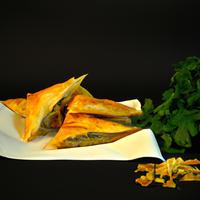
1 serving (28 grams) contains 50 calories, 1.0 grams of protein, 1.0 grams of fat, and 10.0 grams of carbohydrates.

Log this food in SnapCalorie

Nutrition Information
Calories |
427.4 | ||
|---|---|---|---|
% Daily Value* |
|||
| Total Fat | 8.5 g | 10% | |
| Saturated Fat | 0 g | 0% | |
| Polyunsaturated Fat | 0 g | ||
| Cholesterol | 0 mg | 0% | |
| Sodium | 427.4 mg | 18% | |
| Total Carbohydrates | 85.5 g | 31% | |
| Dietary Fiber | 0 g | 0% | |
| Sugars | 0 g | ||
| protein | 8.5 g | 17% | |
| Vitamin D | 0 mcg | 0% | |
| Calcium | 17.1 mg | 1% | |
| Iron | 2.6 mg | 14% | |
| Potassium | 85.5 mg | 1% | |
* Percent Daily Values are based on a 2,000 calorie diet. Your daily values may be higher or lower depending on your calorie needs.
Food Attributes
Source of Calories
About Phyllo pastry
Phyllo pastry, also known as filo, is a delicate, paper-thin dough commonly used in Middle Eastern, Mediterranean, and Balkan cuisines. Its origins trace back to Ottoman times, where it was a staple in dishes like baklava and spanakopita. Made from simple ingredients—flour, water, a touch of oil, and occasionally vinegar—it is layered to create a light, flaky texture. Phyllo is naturally low in fat and calories, making it a thinner alternative to buttery pastries like puff pastry. However, its health profile depends largely on preparation; traditional recipes often use generous amounts of butter or oil between layers. When made with wholesome fillings such as spinach, herbs, and lean proteins, phyllo-based dishes can be nutrient-rich. On the other hand, desserts featuring phyllo are usually high in sugar and saturated fats. Overall, phyllo offers versatility for both savory and sweet recipes while allowing room for healthier adaptations.



